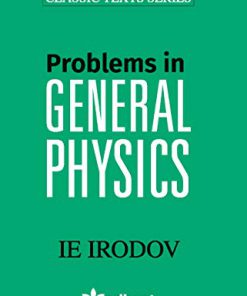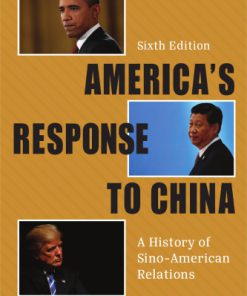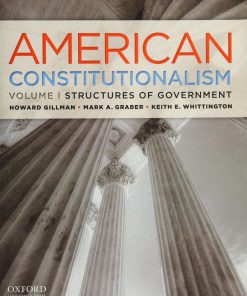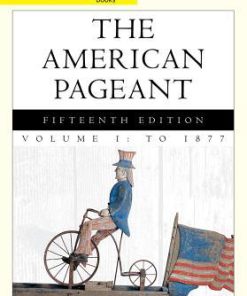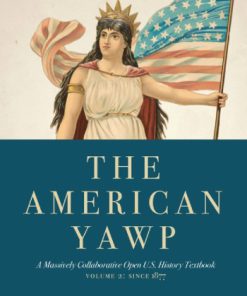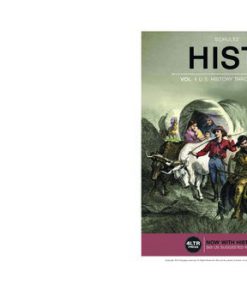Major Problems in American History Volume I To 1877 4th Edition by Elizabeth Cobbs, Edward Blum ISBN 9781305585294 1305585291
$50.00 Original price was: $50.00.$25.00Current price is: $25.00.
Major Problems in American History Volume I To 1877 4th Edition by Elizabeth Cobbs, Edward Blum – Ebook PDF Instant Download/Delivery: 9781305585294 ,1305585291
Full download Major Problems in American History Volume I To 1877 4th Edition after payment
Product details:
ISBN 10: 1305585291
ISBN 13: 9781305585294
Author: Elizabeth Cobbs, Edward Blum
Major Problems in American History Volume I To 1877 4th Edition Table of contents:
Chapter 1. Old Worlds Make New Ones
Questions to Think About
Documents Overview
1. The Iroquois Describe the Beginning of the World, n.d.
2. Native Americans Pay Tithes to the Aztecs, 1541–42
3. European Map-Makers Remake the World, 1595
4. The Portuguese Lament Military Losses in Western Africa, 1448
5. Christopher Columbus Details His First Encounters with Native People, 1493
6. Fray Bernardino de Sahagun Relates an Aztec Chronicler’s Account of the Spanish Conquest of the Aztecs, 1519
7. An Englishman Discusses Trading with Indians on the Atlantic Coast, 1584
8. English Artist John White Depicts Indian Land Use, 1619
Essays Overview
The Indians’ Old World
The Indians’ Old World (continued)
The Indians’ Old World (continued)
The Indians’ Old World (continued)
The Indians’ Old World (continued)
The Indians’ Old World (continued)
The Europeans’ New World
The Europeans’ New World (continued)
The Europeans’ New World (continued)
The Europeans’ New World (continued)
The Europeans’ New World (continued)
The Europeans’ New World (continued)
The Europeans’ New World (continued)
Further Reading
Chapter 2. Colonial Settlements and Conflicts, 1600–1690
Questions to Think About
Documents Overview
1. Edward Waterhouse, a British Official, Recounts an Indian Attack on Early Virginia Settlement, 1622
2. Indentured Servant Richard Frethorne Laments His Condition in Virginia, 1623
3. Puritan Leader John Winthrop Provides a Model of Christian Charity, 1630
4. Sugar Planters Transform Barbados, 1647–1650
5. Anne Bradstreet Discusses Her Children in the Colonies, 1656
6. A French Missionary Describes the Iroquois, 1659–1660
7. George Alsop, a Resident of Maryland, Argues That Servants in Maryland Profit from Life in the Colonies, 1666
8. Tituba, a Servant-Slave in Salem, Massachusetts, Answers Questions About the Devil, 1692
Essays Overview
The Indians’ New World
The Indians’ New World (continued)
The Indians’ New World (continued)
The Indians’ New World (continued)
The Indians’ New World (continued)
The Indians’ New World (continued)
The Indians’ New World (continued)
The Indians’ New World (continued)
Cannibalism and Abundance in Colonial Jamestown
Cannibalism and Abundance in Colonial Jamestown (continued)
Cannibalism and Abundance in Colonial Jamestown (continued)
Cannibalism and Abundance in Colonial Jamestown (continued)
Cannibalism and Abundance in Colonial Jamestown (continued)
Further Reading
Chapter 3. British Colonial Development, 1690–1770
Questions to Think About
Documents Overview
1. An Englishman Recounts His Travels into Western Africa, 1623
2. Virginia’s Statutes Illustrate the Declining Status of African American Slaves, 1660–1705
1660–1661, Act XXII
1662, Act XII
1705, Chap. XLIX
3. Southern Planter William Byrd Describes His Views Toward Learning and His Slaves, 1709–1710
4. Enslaved Workers Cultivate Tobacco, 1738
5. Dr. Alexander Hamilton Depicts the Material Acquisitions of Northern Colonists, 1744
New York
Schenectady
Nantucket Fall…
New London…
6. Gottlieb Mittelberger, a German Immigrant, Portrays the Difficulties of Immigration, 1750
7. Samson Occom (Mohegan) Gives a Short Narrative of His Life, 1768
From My Birth Till I Received the Christian Religion
From the Time of Our Reformation Till I Left Mr. Wheelocks
8. Adam Smith Analyzes the British Colonies in Terms of the Wealth of Nations, 1776
Essays Overview
Worlds of Wonder in the Northern Colonies
Worlds of Wonder in the Northern Colonies (continued)
Worlds of Wonder in the Northern Colonies (continued)
Worlds of Wonder in the Northern Colonies (continued)
Worlds of Wonder in the Northern Colonies (continued)
Worlds of Wonder in the Northern Colonies (continued)
Worlds of Wonder in the Northern Colonies (continued)
Worlds of Wonder in the Northern Colonies (continued)
Worlds of Goods in the Northern Colonies
Worlds of Goods in the Northern Colonies (continued)
Worlds of Goods in the Northern Colonies (continued)
Worlds of Goods in the Northern Colonies (continued)
Worlds of Goods in the Northern Colonies (continued)
Further Reading
Chapter 4. The American Revolution
Questions to Think About
Documents Overview
1. Congress Condemns the Stamp Act, 1765
2. Pamphleteer Thomas Paine Advocates the “Common Sense” of Independence, 1776
3. Abigail and John Adams Debate Women’s Rights, 1776
John Adams Responds
4. Mohawk Leader Joseph Brant Commits the Loyalty of His People to Britain, 1776
5. A New Song Inspires Revolutionaries, 1776
6. African Americans Petition for Freedom, 1777
7. General Washington Argues for Greater Military Funding by Portraying the Plight of Soldiers at Valley Forge, 1778
8. Venezuela Declares Independence, 1810
Act of Independence
Essays Overview
Maritime Dimensions of the American Revolution
The Fisherman’s Cause (continued)
The Fisherman’s Cause (continued)
The Fisherman’s Cause (continued)
The Declaration of Independence in World Context
The Declaration of Independence in World Context (continued)
The Declaration of Independence in World Context (continued)
Further Reading
Chapter 5. From Confederation to Constitution
Questions to Think About
Documents Overview
1. The Articles of Confederation Stress the Rights of States, 1781
Preamble
2. Cato, an African American, Pleads for the Abolition of Slavery in Pennsylvania, 1781
3. The Iroquois and the U.S. Make the Treaty of Fort Stanwix, 1784
Articles
4. Slaveholders in Virginia Argue against the Abolition of Slavery, 1784–1785
5. Thomas Jefferson Proposes the Protection of Religious Freedom in Virginia, 1786
6. Daniel Shays and Followers Declare Their Intent to Protect Themselves against “Tyranny,” 1787
7. The Federalist Papers Illustrate the Advantages of Ratification of the Constitution, 1787–1788
Factions and Their Remedy (James Madison, No.10)
The System of Checks and Balances (Alexander Hamilton or James Madison, No. 51)
A Defense of the Presidency (Alexander Hamilton, No. 69)
8. France Devises a New Republican Calendar, 1793
Essays Overview
The Pressure of the People on the Framers of the Constitution
I. The First Accommodation
II. Ghosts of Years Past
III. Elite Divisions
IV. Democratic Divisions
V. The Second Accommodation
VI. The “Losers’” Role
Making an American Umpire in the Presence of European Empires
Making an American Umpire in the Presence of European Empires (continued)
Making an American Umpire in the Presence of European Empires (continued)
Making an American Umpire in the Presence of European Empires (continued)
Making an American Umpire in the Presence of European Empires (continued)
Further Reading
Chapter 6. Nation Among Nations
Questions to Think About
Documents Overview
1. A Spanish Soldier Describes the Comanche Destruction of the San Saba Mission in Texas, 1758
2. Republican Thomas Jefferson Celebrates the Virtue of the Yeoman Farmer, 1785
3. Judith Sargent Murray Argues for the “Equality of the Sexes,” 1790
4. Federalist Alexander Hamilton Envisions a Developed American Economy, 1791
5. A Cartoonist Attacks the Degenerate French Over the XYZ Affair, 1798
6. Thomas Jefferson Advances the Power of the States, 1798
7. Chief Justice John Marshall Argues for the Primacy of the Federal Government, 1803
8. Thomas Jefferson’s Supporters Sing of His Victory, ca. 1801
Essays Overview
The Comanche Empire
The Comanche Empire (continued)
The Comanche Empire (continued)
The Comanche Empire (continued)
The Comanche Empire (continued)
The Comanche Empire (continued)
The Comanche Empire (continued)
The Making of American Nationalism
New England as America
Further Reading
Chapter 7. Foreign Policy, Western Movement, and Indian Removal
Questions to Think About
Documents Overview
1. President George Washington Warns Against “Entangling Alliances,” 1796
2. William Clark of the Lewis and Clark Expedition Enters into Diplomacy with Native People, 1806
[Speech prepared for Yellowstone Indians]3. Iroquois Chief Red Jacket Decries the Day When Whites Arrived, 1805
4. William Cullen Bryant Satirizes the Embargo Act, 1808
5. Shawnee Chief Tecumseh Recounts the Misdeeds of Whites and Calls for Indian Unity, 1810
6. A Newspaper Reports on the Burning of Washington, D.C., 1814
7. President James Monroe Declares That European Powers May Not Interfere in the Americas, 1823
8. Francis Chardon Bemoans the Destruction of the Arikaras and Mandans by Smallpox, 1837
August 31 Days—1837
September 30 Days—1837
Essays Overview
The War of 1812 as a Borderland War
The War of 1812 as a Borderland War (continued)
The War of 1812 as a Borderland War (continued)
The War of 1812 as a Borderland War (continued)
The War of 1812 as a Borderland War (continued)
The War of 1812 as a Borderland War (continued)
The War of 1812 as a Borderland War (continued)
International Missions and Tenuous Anglo-American Relations
International Missions and Tenuous Anglo-American Relations (continued)
International Missions and Tenuous Anglo-American Relations (continued)
International Missions and Tenuous Anglo-American Relations (continued)
Further Reading
Chapter 8. Market and Transportation Revolutions
Questions to Think About
Documents Overview
1. Slave Charles Ball Mourns the Growth of Cotton Culture and “Sale Down the River,” c. 1800
2. President John Quincy Adams Urges Internal Improvements, 1825
3. A Family in Illinois Struggles with Marketing Their Crops, 1831
4. Harriet Hanson Robinson, a “Lowell Girl,” Describes Her Labor in a Textile Mill, 1831
5. Mary Graham Describes Life on a Commercializing Farm, 1835–1844
6. Author Charles Dickens Describes Travel on an Early Railroad Train, 1842
7. A Guidebook Instructs Women on the Role of Mother, 1845
8. A Northern Advertisement Sells “Southerner Rights Segars,” 1859
Essays Overview
The Market Revolution and the Changes in Women’s Work
The Market Revolution and the Changes in Women’s Work (continued)
The Market Revolution and the Changes in Women’s Work (continued)
The Market Revolution and the Changes in Women’s Work (continued)
The Changes Wrought by Cotton, Transportation, and Communication
What Hath God Wrought
The World That Cotton Made
Overthrowing the Tyranny of Distance
Further Reading
Chapter 9. Nationalism and Sectionalism
Questions to Think About
Documents Overview
1. A New Song Endeavors to Put Andrew Jackson in the White House, c. 1820s
2. Vice President John C. Calhoun Argues That Tariffs Disadvantage the South, 1828
3. A Mexican General Describes the Borderland, 1828, 1829
4. Senator Daniel Webster Lays Out His Nationalist Vision, 1830
5. President Andrew Jackson Condemns the Rights of “Nullification” and Secession, 1832
6. Lieutenant-Colonel José Enrique de la Peña Defends Mexico’s Actions Against the Texans, 1836
7. Michel Chevelier, a French Visitor, Marvels at the Pageantry of Politics, 1839
8. Frederick Douglass Addresses Texas and Slavery While Speaking in Ireland, 1846
Essays Overview
The Rise of Andrew Jackson, the Annexation of Texas, and the Perils and Possibilities of Nationalism and Sectionalism
The Rise of Andrew Jackson, the Annexation of Texas, and the Perils and Possibilities of Nationalism and Sectionalism (continued)
The Rise of Andrew Jackson, the Annexation of Texas, and the Perils and Possibilities of Nationalism and Sectionalism (continued)
The Rise of Andrew Jackson, the Annexation of Texas, and the Perils and Possibilities of Nationalism and Sectionalism (continued)
The Rise of Andrew Jackson, the Annexation of Texas, and the Perils and Possibilities of Nationalism and Sectionalism (continued)
Northerners Begin to the See “the South” as the Problem
Northerners Begin to the See “the South” as the Problem (continued)
Northerners Begin to the See “the South” as the Problem (continued)
Northerners Begin to the See “the South” as the Problem (continued)
Northerners Begin to the See “the South” as the Problem (continued)
Northerners Begin to the See “the South” as the Problem (continued)
Further Reading
Chapter 10. Reform and Religion
Questions to Think About
Documents Overview
1. Peter Cartwright, a Methodist Itinerant Preacher, Marvels at the Power of Religious Revivals, 1801
2. A Journalist Describes a City Prophet and His Attacks on Women
3. Angelina Grimké Appeals to Christian Women to Oppose Slavery, 1836
4. James McCune Smith Applauds the British and French for Ending of Slavery, 1838
5. Reformer Dorothea Dix Depicts the Horrible Conditions Endured by the Mentally Ill, 1843
6. Joseph Smith Records a Revelation on Plural Marriage, 1843
7. The Seneca Falls Convention Declares Women’s Rights, 1848
8. Former Slave Sojourner Truth Links Women’s Rights to Antislavery, 1851
Essays Overview
Religion as Inhibiting and Liberating: The Complicated Case of Sojourner Truth
Religion as Inhibiting and Liberating (continued)
Religion as Inhibiting and Liberating (continued)
Religion as Inhibiting and Liberating (continued)
Religion as Inhibiting and Liberating (continued)
Religion as Inhibiting and Liberating (continued)
Slavery, Sex, and Transatlantic Abolitionism
Slavery, Sex, and Transatlantic Abolitionism (continued)
Slavery, Sex, and Transatlantic Abolitionism (continued)
Slavery, Sex, and Transatlantic Abolitionism (continued)
Slavery, Sex, and Transatlantic Abolitionism (continued)
Slavery, Sex, and Transatlantic Abolitionism (continued)
Further Reading
Chapter 11. Commercial Development and Immigration
Questions to Think About
Documents Overview
1. Alexis de Tocqueville Marvels at the Mobile Northern Society, 1831
2. Essayist Orestes Brownson Condemns the Plight of “Wage Slaves,” 1840
3. Gustof Unonius, a Swedish Immigrant, Reflects on Life in the United States, 1841–1842
4. New Yorker George Templeton Strong Berates the Immigrants in His Midst, 1838–1857
5. John L. O’Sullivan, a Democratic Newspaperman, Defines “Manifest Destiny,” 1845
6. Commodore Matthew C. Perry Receives Instructions for His Expedition to Japan, 1852
7. A Magazine Author Reflects upon the Impact of Gold and Silver from California and Elsewhere in the World, 1852
8. Irish Americans Sing about Their Struggles and Successes, c. 1860s
Essays Overview
Concentrating Capital and Power in New York City
Concentrating Capital and Power in New York City (continued)
Concentrating Capital and Power in New York City (continued)
Concentrating Capital and Power in New York City (continued)
Concentrating Capital and Power in New York City (continued)
The Hard Quest for Quick Riches in California
The Hard Quest for Quick Riches in California (continued)
The Hard Quest for Quick Riches in California (continued)
The Hard Quest for Quick Riches in California (continued)
The Hard Quest for Quick Riches in California (continued)
The Hard Quest for Quick Riches in California (continued)
The Hard Quest for Quick Riches in California (continued)
Further Reading
Chapter 12. Agriculture and Slavery in the South
Questions to Think About
Documents Overview
1. A North Carolina Law Prohibits Teaching Slaves to Read or Write, 1831
2. Ferdinand L. Steel Records Daily Life as a Yeoman, 1838–1841
3. Cotton Planter Bennett Barrow Describes Life in Louisiana, 1838, 1839, 1841
4. Samuel Cartwright, a Southern Doctor, Theorizes about the Peculiar Diseases of Slaves, 1851
5. A Virginia Slave Woman Articulates Her Distress to Her Enslaved Husband, 1852
6. Southern Author Daniel Hundley Robinson Depicts the White Yeoman Farmer, 1860
7. Harriet Jacobs Deplores Her Risks in Being a Female Slave, 1861
8. Southerner Mary Chestnut Describes Her Hatred of Slavery from a White Woman’s View, 1861
Essays Overview
The Neighborhoods and Intimate Lives of Slaves
The Neighborhoods and Intimate Lives of Slaves (continued)
The Neighborhoods and Intimate Lives of Slaves (continued)
The Neighborhoods and Intimate Lives of Slaves (continued)
How Slaves Transformed Jails
Slaves in Jail
Slaves in Jail (continued)
Slaves in Jail (continued)
The Politics of Talk
Further Reading
Chapter 13. Toward Civil War
Questions to Think About
Documents Overview
1. J. Stoddard Johnston Answers “What Is a Yankee,” 1850
Anecdotes
2. Reviewers Offer Differing Opinions about Uncle Tom’s Cabin, 1852
3. Axalla John Hoole, a Southerner, Depicts “Bleeding Kansas,” 1856
4. Senator Charles Sumner Addresses the “Crime against Kansas,” 1856
5. Chief Justice Roger Taney Determines the Legal Status of Slaves, 1857
6. Republican William Seward Warns of an Irrepressible Conflict, 1858
7. James Henry Hammond Praises King Cotton, 1858
8. Feuille du Commerce Eulogizes John Brown, January 21, 1860
9. Northerner Frederick Law Olmsted Depicts the Economic Costs of Slavery, 1861
Essays Overview
Why Northerners Voted for Abraham Lincoln
Why Northerners Voted for Abraham Lincoln (continued)
Why Northerners Voted for Abraham Lincoln (continued)
Why Northerners Voted for Abraham Lincoln (continued)
Why Northerners Voted for Abraham Lincoln (continued)
Why Northerners Voted for Abraham Lincoln (continued)
Why Northerners Voted for Abraham Lincoln (continued)
Why Northerners Voted for Abraham Lincoln (continued)
Why Northerners Voted for Abraham Lincoln (continued)
Why Northerners Voted for Abraham Lincoln (continued)
How Cotton Wove Together a Secession Coalition
How Cotton Wove Together a Secession Coalition (continued)
Converting Friends to Enemies and Enemies to Friends: The Search for Natural Allies
Realists Decide: Election and Secession
Realists Decide (continued)
Further Reading
Chapter 14. The Civil War
Questions to Think About
Documents Overview
1. A White Virginian Argues against Secession, 1861
2. The Detroit Soldiers’ Aid Society President Calls on Women to Assist the War Effort, 1861
3. Cherokee Declare Their Support for the Confederacy, 1861
4. Margaret Junkin Preston Describes Southern Suffering in Her Diary, 1862
5. President Abraham Lincoln Orders the Execution of 39 Dakotas Involved in the 1862 Minnesota War
6. James Henry Gooding, an African American Soldier, Pleads for Equal Treatment, 1863
7. Tally Simpson, a Confederate Soldier, Recounts the Battle of Gettysburg, 1863
8. Two Artistic Representations of Emancipation, 1863, 1864
9. Karl Marx Applauds Abraham Lincoln, 1864
10. Liberian Secretary of State Hilary Johnson Responds to the Assassination of Abraham Lincoln, 1866
Essays Overview
The Good Death in the Civil War
The Good Death in the Civil War (continued)
The Good Death in the Civil War (continued)
The Hard Freedom of the Civil War
The Hard Freedom of the Civil War (continued)
The Hard Freedom of the Civil War (continued)
A Story Too Long in the Shadows
A Story Too Long in the Shadows (continued)
A Story Too Long in the Shadows (continued)
A Story Too Long in the Shadows (continued)
Further Reading
Chapter 15. Reconstruction
Questions to Think About
Documents Overview
1. William Howard Day, an African American Minister, Salutes the Nation and a Monument to Abraham Lincoln, 1865
2. A Southern Songwriter Opposes Reconstruction, c. 1860s
3. Louisiana Black Codes Reinstate Provisions of the Slave Era, 1865
4. Congressman Thaddeus Stevens Demands a Radical Reconstruction, 1867
5. Thomas Nast Depicts Contrasting Views of Reconstruction, 1866, 1869
6. Elizabeth Cady Stanton Questions Abolitionist Support for Female Enfranchisement, 1868
7. Charlotte Forten Reflects on Teaching Among Southern African Americans, 1863
8. Lucy McMillan, a Former Slave in South Carolina, Testifies about White Violence, 1871
9. Francis Miles Finch Mourns and Celebrates Civil War Soldiers from the South and North, 1867
People also search for Major Problems in American History Volume I To 1877 4th Edition:
major problems in american history volume 2 pdf
major problems in american history since 1945 pdf
major problems in american history volume ii 4th edition
major problems in american history volume 2 4th edition
Tags:
Elizabeth Cobbs,Edward Blum,Major Problems,American History,Volume I,1877
You may also like…
Physics - General Courses
Politics & Philosophy - Anthropology
America s Response To China A History Of Sino American Relations Warren I. Cohen
History - American Studies
Religion & Spirituality
Politics & Philosophy - Anthropology
History - American Studies
HIST 5 Volume 1 US History Through 1877 5th Edition by Kevin Schultz ISBN 1337294160 9781337294164
Uncategorized
Kaufman s Clinical Neurology for Psychiatrists Major Problems in Neurology 9th Edition Kaufman Md
Politics & Philosophy - Anthropology
Major Problems in American History Volume II Since 1865 Elizabeth Cobbs




